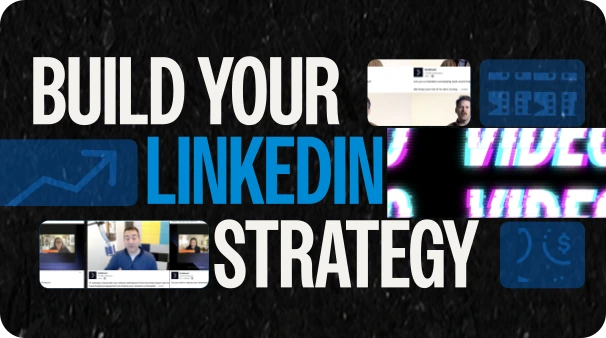How Strategic Influencer Partnerships Can Win You B2B Mindshare

Table of Contents
Maximize Your Marketing ROI
Join 10,000 other marketers already getting the best tips on running engaging events that boost pipeline and create raving fans.
In the current B2B market, buyers know who they want to buy from before they even reach out to your company. This is why winning Mindshare — your audience's valuable mental real estate — is critical, and working with key influencers can help you get there.
Our March Insider event, in partnership with MarketingProfs, featured Cindy Dubon, Goldcast's Head of Growth, in conversation with Vin Matano of Creatorbuzz, a B2B influencer marketing agency. Vin's worked with 50+ brands, from Adobe to LinkedIn, on influencer marketing initiatives, and he had a lot of great insight to share.
Read on to learn:
- The importance of Mindshare and how influencers affect it
- Video content drives Mindshare, and Mindshare drives revenue
- 4 practical tips to win Mindshare with influencer marketing
- Watch the full episode for the Mythbusters segment on influencer marketing
- Strategic influencer partnerships FAQs
PS: There are a lot of great nuggets in the full replay, including a Mythbusters session debunking common misbeliefs around influencer marketing. Give it a watch below!
The importance of Mindshare and how influencers affect it
First, let's recap why Mindshare even matters.
According to the 6sense 2024 Buyer Experience Report, 81% of buyers have a preferred vendor by the time they reach out, and 85% have already identified their purchase requirements. In this environment, people know what they want!
Beyond that, Sprout Social notes that almost half of consumers make purchasing decisions based on influencer posts. People are tired of the constant noise and paid ads, and they want to hear from communities and people they trust. This underscores the importance of partnering with the right people to amplify your message and drive revenue.
Check out the video below for Cindy's story about how she decided on Goldcast when she was working at a different company:
Cindy's story perfectly illustrates why Mindshare is critical. She did her research by asking people for recommendations, and she already knew she wanted to go with Goldcast before she requested demos. At that point, buyers are mostly looking to the sales and demo process to validate their decisions.
Video content drives Mindshare, and Mindshare drives revenue
It's practically impossible to win deals and drive revenue if you don't have Mindshare. If you're looking for a place to start, video is the answer!
At the end of the day, if you're not top of mind, you're forgotten. - Cindy Dubon, Head of Growth, Goldcast
From the start, we've been all-in on video as the way to connect with your audience. And we've got good news for B2B companies — LinkedIn is now prioritizing video content more than ever, and it's a great time to start posting videos to the feed. LinkedIn is currently testing a video-only feed, and we'll soon see a lot more new features rolled out with it.
Vin shared that only 1% of LinkedIn users are actually creating content, and a smaller fraction of that create videos. That leads to a video feed that's full of people consuming the videos but not posting original ones of their own. In other words, there's a content deficiency issue when it comes to videos on LinkedIn, creating a big opportunity to get more reach on your videos.
As of press time, video uploads on LinkedIn were up 34%, which is an encouraging sign. LinkedIn is urging video creators from Instagram, TikTok, and YouTube to migrate over and post content on LinkedIn, which is helping fill the gap, and those LinkedIn videos typically get twice the engagement you would expect from other posts.
Note: While many social media videos are all about entertainment, LinkedIn video content should still be about sharing knowledge. What can you create that relates to your job, role, career, company culture, or something that would be valuable to the audience? Of course, that doesn't mean you can't have fun with the videos, but you still need to provide value.
4 practical tips to win Mindshare with influencer marketing
If you're thinking about partnering with an influencer, you want to have a strategy in place. Here are a few approaches to consider:
1. Full-funnel content approach
You don't want to reach out to an influencer, create one piece of content, and then leave it at that. A full-funnel content approach takes all of your personas into account, as well as the different customer journey stages, and creates content to speak to each of them.
For Storyline, they have edutainment creators creating ToFu content, as well as more tactical videos around how to actually use the tool. For each segment, influencers create videos to speak to that demographic, building Mindshare along the way.
2. Thought leader ads
It's common to think of influencer relationships as a situation where you pay someone for a post, and that sums it up. However, the best relationships are the long-term ones, where you can work with influencers for thought leadership ads.
Real quick: a definition! Thought leader ads are ads that you run from your ad account, but they boost a third-party page. Say Goldcast wanted to run a thought leader ad on a post by Vin about us. The budget would come from our in-house ad account, but the ad would come from Vin's post. It's like a boosted post — visually, the posts look like organic posts within the feed, which is good for engagement because people prefer interacting with humans over brands.
You may have seen some of this content coming recently from Intuit; they're running these ads with creators who are already active on LinkedIn, as well as people who aren't that big on LinkedIn but are great at creating content and fit the profile of their target users.
3. Content distribution
Did you catch the Hootsuite ads promoting their latest benchmark report?
It's smart to use influencers to help with content distribution around things you already own! In this case, Hootsuite already put a ton of time and energy into their report — why not get more eyes on it by partnering with influencers to promote it?
According to Hootsuite's CEO, this "stunt" led to the most content downloads of any influencer campaign. In fact, 66% of all report downloads came from this campaign and it generated 1M in pipeline!
This campaign is also proof that it's easier to be original in the B2B space. Take advantage of that! The "big newspaper" trend wouldn't feel as original in the B2C space because it's already been done, but consumers want to see that same energy from B2B companies.
4. Employee generated content (EGC)
The call isn't always coming from outside the house, by the way — your internal workforce can turn out to be great influencers!
Gong has really popularized this model, encouraging staff members to become creators in their own right. EGC can include content by your company founders and leadership team, who can share business updates and thoughts on what's happening in the industry.
Some recs to get started:
- Start with your founder. They may feel like they don't have time, but you can always hire contractors or agencies to do the actual writing for leaders. Some teams out there right now have full teams in place, just for founder-generated content!
- Share personal experiences. People want to know who they're buying from and they want to hear about what's going on in the business.
- Once the founder has built some awareness, then start asking specific roles to post individualized content. Put people on your webinars and podcasts to give them a voice.
EGC has pretty low barriers to entry, and team members can start establishing relationships with their audiences and boosting brand awareness. Be sure that each person infuses their particular personality, as well as their job expertise, into the content. If you've got an Ops person, they should be talking about something related to Ops that the audience will find valuable.
Watch the full episode for the Mythbusters segment on influencer marketing
Is influencer success all about follower count or paying for endorsements? Should you give influencers free rein to do their thing when you work together? Is success measured by views and likes? What's the difference between "window content" and "mirror content"?
Get answers to these questions and more with the episode replay! Cindy and Vin did a complete Mythbusters-style breakdown of five common misconceptions around influencer marketing, and the answers might surprise you.
Strategic influencer partnerships FAQs
Q: How do I find influencers to work with?
A: This is the age-old question!
The answer depends on what you want out of a given campaign. Creators are good at different things, and some don't do video at all (a big missed opportunity, if you ask us). You need to be clear on what you're hoping to achieve so you can find creators who do that well.
It's a good idea to look within specific communities. If you sell to a particular persona, find out where they hang out. Dive into that world, and see who the thought leaders are. Who do people look to for advice and recommendations? Then try to work with those people.
One other idea is to explore your customer base and see if you can get some of your customers to create content about your brand! People really listen to their peers, so this can be a great way to influence Mindshare.
Q: What equipment do I need to post good video content?
A: Invest in a good microphone, at the very least. Camera quality is actually less important than audio quality. When you're filming, try to position yourself in front of a natural light source like a window.
Remember: You don't have to invest a ton at first! The most important thing is to create a compelling story and get started.
Q: What tools do you recommend for smaller marketing teams trying to create video?
A: Check out the free version of Content Lab, which allows you to upload one hour of video per month and quickly repurpose it into video clips, social media posts, and other content assets. You can also look into Final Cut Pro for video editing if you're less focused on repurposing and more invested in the editing side of things.
Stay In Touch
Platform
Resources
Company
Community
© 2025 Copyright Goldcast, Inc. All rights reserved.



 Upcoming Events
Upcoming Events Event Series
Event Series On-Demand Events
On-Demand Events

